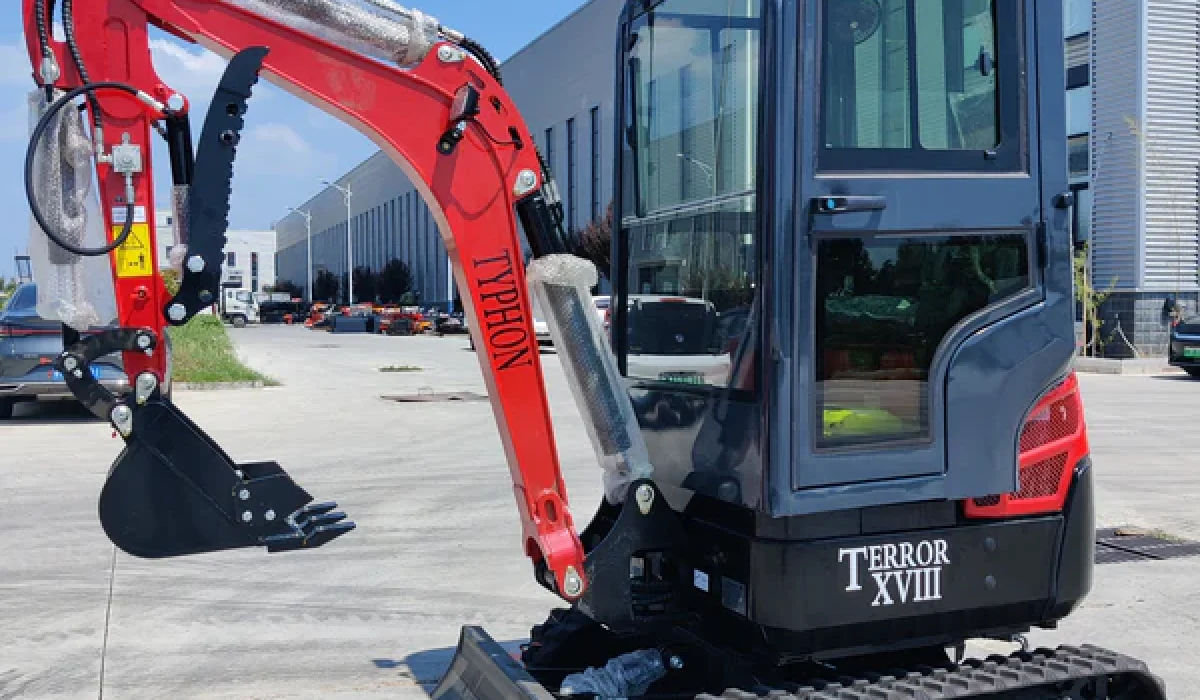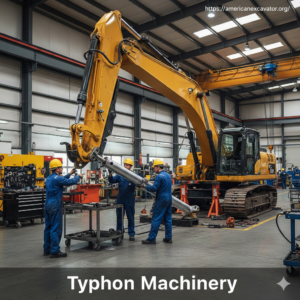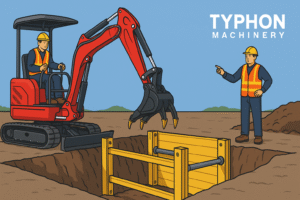When you need a solution to finish more work on building projects within limited time and high-quality standards without exhausting your employees, mini excavators might be used. You also want light-weight, agile tools that can pass gates, negotiate uneven ground, and turn without damaging surrounding machinery or structures. Often the greatest option are mini excavators, often called small excavators. Given their great mobility and little chance of harm, they provide the power you need to do jobs fast.
For what purpose does a Mini Excavator find application?
Different tasks may be accomplished with these compact excavators based on their size. Usually, they are used for backfilling, leveling, grading, excavation, trenching, and even drilling. The Mini Excavator finds use in the following:
Even in the smallest backyards, mini excavators are the best tool for excavating in-ground pools or hot tubs. Residential earthworks like the equipment due to its mobility, power, and precise handling.
Mini Excavators let operators reach tiny areas near buildings and efficiently move dirt while repairing sewer pipes. These devices are also employed, attached like a dozer blade, to level the yard after repairs.
Mini excavators shine in digging because of their remarkable capacity to fit in confined areas and the variety of attachment options they provide. Conventional shoveling takes time and effort and might cause projects to take much more time to complete. Still, digging with a little digger is effective and quick. Digging holes for tree transplanting is easier with a little excavator. It can even remove bigger trees with the proper attachments.
Moreover, demolition might benefit from small excavators. Although many development projects include destroying minor structures such as sheds and other outbuildings, it is unlikely that you would require a small excavator. Mini excavators are considerably safer and more efficient than hand-powered tools for disassembling tiny buildings. Their tiny and neat form allows them to pass gates and other restricted areas on the work site.
Mini excavators help to speed up and ease landscape upkeep. Instead of hand shoveling dirt, dig trenches for irrigation or plantings with a small excavator. Without leaving appreciable track marks or damaging the soil or vegetation, a portable mini excavator can swiftly traverse the ground.
How operates a mini excavator?
Using mini excavators helps many building projects be more safe and efficient. Their small profile helps them to move quickly into confined areas, therefore accelerating different duties. The following describes several mini excavator operating techniques:
Make sure you understand the location and goal of every control before starting operation. Never change the manner in which the control lever is operated. Should the operator neglect to do it, machine malfunction will follow.
Run the machine efficiently utilizing the boom swing option while digging grooves adjacent to roadsides or walls. The operator operates the boom swing using the boom-swing pedal on his right foot.
Rising and lowering the blade using the lever on the operator’s right side Released, the blade lever instantly returns to neutral, holding the blade in position until the lever is pushed once again.
The pilot control shut-off lever serves to stop machine malfunction should the control levers be inadvertently altered upon operator leave or entry into the cab. For maintenance and quicker access to the operator’s station, the console lock mechanism is coupled to the pilot control shut-off lever.
Park the machine on level, solid ground. Lower the blade and bucket to the floor. Neutral all the control levers. Correctly stop the engine. Pull the pilot control shut-off lever to bring the console to full lock position.
Hydraulic oil’s normal working temperature falls between 50 and 80 °C (122 and 176 °F). Hydraulic components may suffer significant damage if the machine runs when the hydraulic oil temperature is less than 20 °C (68 °F.). Before starting any operation, use these warm-up techniques until the hydraulic oil temperature is above 20 °C (68 °F).
Use the right arm and bucket for the task while running the backhoe. Mostly using the arm as the digging power, pull the bucket toward the machine. Move the arm and/or bucket fast back and forth to remove dirt that binds to it. With the bucket’s bottom at a 45-degree angle, lay the bucket teeth on the ground. Position the rails parallel to the trench while straight line trenching. Move the equipment as necessary to extend the trench after excavating to the needed depth. Try not to bottom the cylinder while running the arm to avoid cylinder damage.
Use the blade for general grading operations after excavation and for soil replenishment in grading operations. Simultaneous operation of the boom, arm, and bucket allows one to grade.
Grading from the front to the backward, slowly roll in the arm and gently raise the boom. Slowerly descend the boom as soon as the arm reaches the vertical position to enable horizontal movement of the bucket. As said previously, operate the arm and bucket rolled back from the backward to the front.
Travel neither while pushing the bucket teeth into the ground nor lift the back of the machine to use the weight as more digging power. Severe machine damage might therefore follow.
Dig with a little excavator?
Operators have to first be conversant with the tools and their features. The worst mistake a user can make is pushing a little excavator beyond of its capacity. Digging should include precise, fluid cuts to guarantee that the equipment runs well. Taking a too big “bite” loses both gasoline and energy by forcing the hydraulics above to release pressure and slowing the work equipment. Digging should see the equipment positioned for material loading at a productive height.
The bench’s height should be very similar to the sideboards on the haul truck. Most experts advise the left side of the machine—which offers the best loading angle and vision—that which should be used for the truck descent. Beyond these fundamental digging techniques, operators must understand how approaches differ depending on the project or application in progress.
One advantage of a Mini Excavator is that demand for these little excavators has surged throughout the previous 10 years. Though they seem little, mini excavators have great power to do a range of jobs.
This particular kind of tool features a small body that can fit many bucket sizes and attachment kinds. You may therefore quickly modify it to suit a range of employment. In terms of operation, a mini excavator is simple. Usually, you may operate the machinery without appointing a particular staff member. Almost everyone can learn the procedure in few hours.
Among the many negatives of hydraulic excavators are their limited access to restricted areas. This makes it rather difficult to achieve precision in a project, including tiny areas. This creates a concern for tasks like roadwork and related ones. A Mini Excavator will help you to address such issues. Short tail or zero tail characteristics enable these little excavators to move and rotate with limited regions of limitation.
Moving equipment is sometimes challenging. You will have to make plans whether you are renting the equipment and want to get it from the dealer to your job site or if you want to move the machine from one area to another. If one uses a mini excavator, the challenges are much reduced. They fit well in either long pickup beds or even pickup truck trailers.
The operation of the mini excavator is not limited by its dimensions. Since these little excavators still have 360 degree swinging capability. The little excavator will only swing to load the dump truck from wherever it is positioned; you do not have to relocate dump trucks to suit the positioning of these small excavators.
Every client’s main goal is to do the task for the least amount of money needed. Because of its cheaper cost, a mini excavator is suitable for modest to medium-sized tasks. They provide the expected results without taxing the capital expenditure budget of the business too much.
Its decreased rate of wear and tear and reduced fuel usage demand also help to cut variable expenses like maintenance and replacement.
Less fuel and fewer emissions are produced by a mini excavator than by a conventional one.
By adjusting the RPM of the engine, one may help to avoid the machine from squandering more fuel while generating no additional output; so, resources can be utilized to their best advantage. Furthermore, enhancing cycle time and productivity is the hydraulic system. This is a cost-cutting plan meant to reduce the continuous running costs of the employment.
One other advantage of these mini excavators is their relative silence as compared to standard hydraulic excavators. They are effective workers on any kind of working site without drawing attention.
Specifications for a small excavator:
Usually, mini excavators are classified according to their running weight. Two types of mini excavators are 2 tons (2.3 tons) and 3 tons (3.3 tons). Regarding the Mini excavator characteristics, model-to-model differences exist in the horsepower of the engine. The hydraulics running the engine define most specifications. A tiny excavator’s front side runs with a boom, arm, and bucket.
Designed with a canopy or cabin, it has two joysticks to operate the boom, arm, and bucket, two pedals for movement of the mini excavator, one dozer blade, and a tiny joystick for the movement of the dozer blade for safety. It has an undercarriage and a boom swing pedal as well. The small excavators are distinctive and flexible, as their alternative attachments cover a great range.





